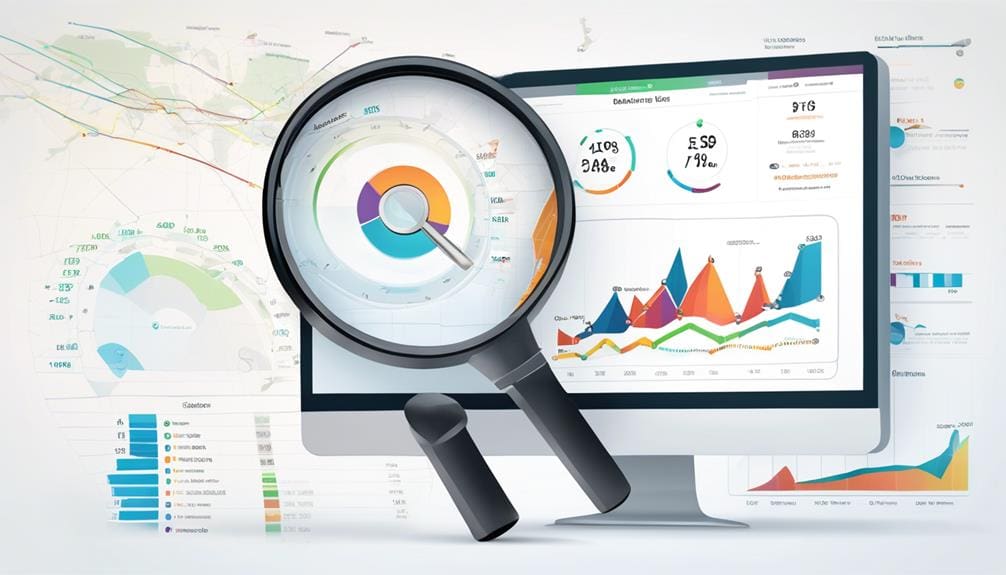
As we navigate the intricate web of local SEO, it's essential to shine a spotlight on the metrics that truly matter. We've distilled the vast ocean of data into nine key metrics that can make or break your local SEO success. From the crucial insights offered by Google My Business to the nuanced subtleties of customer review analysis, these metrics provide a roadmap for actionable improvements. We understand that climbing the rankings in local search isn't just about visibility—it's about being seen by the right eyes and converting that visibility into tangible growth. In the following discussion, we'll unpack these metrics, exploring how each one contributes to a holistic strategy that aims to elevate your local online presence. Join us as we uncover how to harness these metrics to finesse your local SEO strategy, leaving no stone unturned in your quest for digital dominance in your local market.
Google My Business Insights
Leveraging Google My Business Insights, we can closely examine how potential customers interact with our online business listing, pinpointing precisely what drives engagement and where we can enhance our local SEO efforts. These insights offer granular data on page views and customer actions, such as phone calls, form submissions, and direction requests via Google Maps.
By monitoring these Local SEO Metrics, we're equipped to measure our Local SEO performance accurately. We can observe search volume trends and how often our Google Business Profile appears in local listings. This knowledge lets us refine our local marketing strategies to target the most effective keywords and geographic areas.
Moreover, comparing our photo views to competitors gives us an understanding of our visual content's impact. High engagement with our images can translate into more Leads Generated. We're committed to using these insights not just to track, but to actively improve our business listings' performance.
As we delve into these analytics, we prioritize actions that align with our findings. We'll adjust our Google My Business (GMB) profile accordingly to optimize user engagement, ensuring that every tweak we make is a step toward data-driven local SEO supremacy.
Organic Local Rankings

Understanding our business's organic local rankings is essential, as they determine our visibility in search engine results for local queries relevant to our products and services. To secure a dominant position, we must master the art of local SEO and leverage Local SEO KPIs effectively. Let's delve into the metrics that will help us gauge our success and drive more organic traffic.
- Search Ranking: Track our position for local keywords to measure improvements over time.
- Google My Business Page: Regularly update and optimize to enhance relevance and prominence.
- Local Pack Presence: Aim to rank well within the coveted local pack for increased visibility.
- Organic Traffic: Monitor the influx of visitors from local searches to assess engagement.
- Local Search Engagement: Evaluate actions taken by users, such as calls or direction requests from our listings.
Local Citation Accuracy

Ensuring the accuracy of our local citations is a critical step in optimizing our business's online presence and boosting our local search rankings. As we delve deeper into the realm of local SEO, we recognize that our business's details must be consistent across all digital marketing platforms. This includes Google My Business, industry-specific directories, and local business listings.
Inaccurate citations can harm our domain authority and confuse Google, which may result in our brand name dropping from the coveted local pack. It's not only about avoiding negative impacts; accurate local citations are a linchpin for attracting local clients and increasing local foot traffic. They serve as a beacon for search engines to validate our business's legitimacy and relevance.
We leverage SEO tools such as Moz Local, Yext, and BrightLocal to track and manage our local citations, eradicating duplicate listings and outdated information. By integrating Google Search Console and Google Analytics, we gain insights into how our citations influence search performance and website traffic.
Our action plan is clear: we regularly monitor and update our citations to align with our current business information. This continual refinement ensures we present a trustworthy and authoritative image to both Google and potential customers, which is paramount for thriving in today's competitive local search landscape.
Customer Review Analysis

As we examine customer review analysis, we'll consider how online testimonials reflect our service quality and client happiness. We'll assess the impact of ratings on our local SEO efforts and determine actionable strategies for improvement. It's crucial we also focus on effectively responding to user critiques to bolster our reputation and foster trust.
Analyzing Online Testimonials
How do customer reviews shape the perception of a local business in the digital landscape? They're pivotal for brand awareness and can substantially impact local SEO. When we analyze online testimonials, we're not just looking at ratings; we're dissecting the nuances that influence organic search rankings and conversion rates. Here's what we focus on:
- Sentiment trends to gauge overall customer satisfaction.
- Keyword mentions that highlight service strengths or issues.
- Response strategies that can mitigate bounce rate increases.
- Correlation between positive reviews and track website clicks.
- Impact on website traffic patterns from social media and referring domains.
Ratings Impact on SEO
Continuing from the analysis of online testimonials, we'll now examine how customer ratings can significantly influence local SEO performance. It's important to look at how positive reviews enhance visibility and credibility, thereby boosting conversion rates. An important metric to track is the Average Page Load time; as page load time increases, potential customers may leave, leading to a high bounce rate. By ensuring a quick and responsive site, we not only improve user experience but also lower bounce rate, which is beneficial for both customers and search engine rankings.
Furthermore, actively managing our online reputation on platforms like Google My Business and Yelp is key to strengthen our local SEO. Promptly responding to reviews demonstrates engagement and can lead to higher ratings, further solidifying our local search presence.
Responding to User Critiques
In the realm of local SEO, promptly addressing user critiques through customer review analysis is pivotal for refining our service offerings and fortifying our online reputation. We recognize that:
- User experience is directly influenced by how we handle feedback, which can affect the conversion rate.
- Quick response to reviews can reduce page loading issues and prevent a higher bounce rate.
- By identifying top exit pages, we can pinpoint where users most often leave and address potential issues.
- Tracking phone calls through an analytics tool helps correlate customer sentiments with real-world actions.
- Continuous improvement in SEO performance encourages more customers to visit your website.
Click-Through Rate (CTR)

We'll delve into how Click-Through Rate (CTR) serves as a critical metric for assessing the effectiveness of your local SEO efforts, influencing how potential customers engage with your online presence. CTR measures the percentage of users who click on a specific link relative to the total number of times the link was shown (impressions), providing insight into the relevance and appeal of your listings.
To master local SEO, it's essential to track and analyze CTR. This metric reflects the immediate response of users to your search result listings. A higher CTR suggests that your meta titles and descriptions resonate well with search queries, capturing the attention of your target audience.
We must measure CTR to gauge the success of our keywords and ads. If we're seeing less than ideal click-throughs, we should consider optimizing our meta titles, descriptions, and even the landing page experience. Additionally, monitoring CTR helps us understand the impact of changes in search traffic and can indirectly influence our conversion rate.
Website Engagement Metrics

Understanding website engagement metrics is crucial for determining how effectively visitors are interacting with your site's content and features. These metrics offer invaluable insights into user behavior, allowing us to refine our strategies for local SEO success.
Here's what we need to focus on:
- Bounce Rate: A higher bounce rate indicates that landing pages may not be resonating with visitors or fail to fulfill user intent.
- Conversion Rate: Evaluating the percentage of visitors who complete desired actions, such as form submissions, is key to understanding the effectiveness of our website content.
- Cost Per Conversion: We must analyze whether the investment into attracting users is yielding an acceptable return based on the cost per conversion.
- Page Traffic: Tracking page traffic helps identify which pages capture the most attention and where to concentrate our content optimization efforts.
- Load Times: Ensuring quick load times is essential as they greatly impact user experience and, consequently, engagement metrics.
Local Conversion Rates

Building on the insights gained from website engagement metrics, let's now focus on optimizing local conversion rates to amplify our local SEO success. Understanding the weight of local conversion rates is pivotal in gauging the effectiveness of our SEO strategies. These metrics not only reflect the percentage of relevant traffic that completes a desired action within our target area but also signal the quality of our search engine ranking.
To measure success, we meticulously track conversion rates for each local page and specific landing pages. This granular approach allows us to evaluate and hone our local SEO efforts, ensuring we attract not just traffic, but traffic that converts. Benchmarking these rates, particularly before and after marketing campaigns, gives us actionable insights into the impact of our strategies.
We're always optimizing, using conversion rate data to fine-tune our marketing efforts. Monitoring the cost per conversion against the revenue generated informs our decisions and investment allocations. Our aim is to not only increase local foot traffic but to do so cost-effectively.
Ultimately, our mastery in managing local conversion rates lies in continuous measurement, analysis, and refinement. By doing so, we ensure that our local SEO endeavors lead to tangible business growth.
Mobile Search Performance

Analyzing mobile search performance is crucial, as it directly impacts how effectively we connect with the increasing number of users who rely on mobile devices for their search needs. As experts in local SEO, we understand that a robust mobile strategy is paramount to our success. Our target audience is constantly on the go, and their search behaviors reflect this dynamic lifestyle. To stay ahead, we must ensure our local pack listings and organic search results are mobile-optimized.
To help us navigate this terrain, here are important metrics we use to measure mobile search performance:
- Mobile Traffic Percentage: The share of visitors accessing our site via mobile devices.
- Bounce Rate on Mobile: How quickly users leave our site after arriving via mobile search.
- Mobile Conversion Rate: The effectiveness of our mobile site in converting visitors into customers.
- Page Load Time on Mobile: Speed influences user experience and ranking position.
- Mobile-Friendly User Experience: Ensuring our site is easily navigable on smartphones and tablets.
Focusing on these metrics enables us to tailor our approach to meet the needs of our mobile users and improve our standings in search engine results. The top 3 local SEO strategies prioritize mobile search performance because it's where a significant segment of our audience is making their purchasing decisions.
What Metrics Should I Focus on for Local SEO Success?
When it comes to achieving success with local SEO, focusing on key insights local SEO traffic is crucial. Paying attention to metrics such as organic traffic, local keyword rankings, online customer reviews, and Google My Business listing engagement can provide valuable insight into the effectiveness of your local SEO strategy.
Local Backlink Profile

While we optimize our mobile search performance, we also need to concentrate on enhancing our local backlink profile, a key factor in boosting our local SEO rankings. A strong domain with a healthy backlink profile establishes authority and relevance, which are pivotal in climbing the ranks, especially within the local pack.
To master our local backlink profile, we must first use tools like Ahrefs or a backlink checker to scrutinize the current landscape. These tools help us determine the number of backlinks, the quality of those links, and the diversity of the referring domains. We're looking for high-quality, do-follow links that contribute positively to our local SEO efforts.
However, we must remain vigilant against toxic backlinks that could negatively impact our rankings. Regular audits allow us to identify and disavow these harmful links, ensuring they don't undermine our efforts in driving business through local search.
In our pursuit of local SEO success, we aim to build a backlink profile that reflects our local foot in the market. By meticulously managing our links and fostering connections with reputable local sources, we bolster our position in local search results and drive targeted traffic to our business.
Frequently Asked Questions
How Is Local SEO Measured?
We measure local SEO by analyzing on-page signals, improving map rankings, and optimizing for mobile. We focus on building links, managing local citations, and enhancing user experience for better behavioral metrics and review signals.
What Metrics Should I Track for Seo?
We're tracking organic traffic, conversion rates, click-through and bounce rates, page speed, mobile optimization, backlink quality, domain authority, local listings, and citation consistency to refine our SEO strategy and enhance performance.
What KPIs Should Be Measured for Seo?
We're measuring KPIs crucial for SEO, including organic visibility, citation consistency, and mobile optimization. Our focus also encompasses review management, link and behavioral signals, local content creation, social engagement, brand mentions, and optimizing user experience.
How Do You Measure the Success of Seo?
We measure SEO success by analyzing organic traffic, bounce rate, conversion rate, click-through rate, keyword rankings, page speed, domain authority, backlink profile, user engagement, and content quality to continuously improve our online presence.
RELATED POSTS
View all



